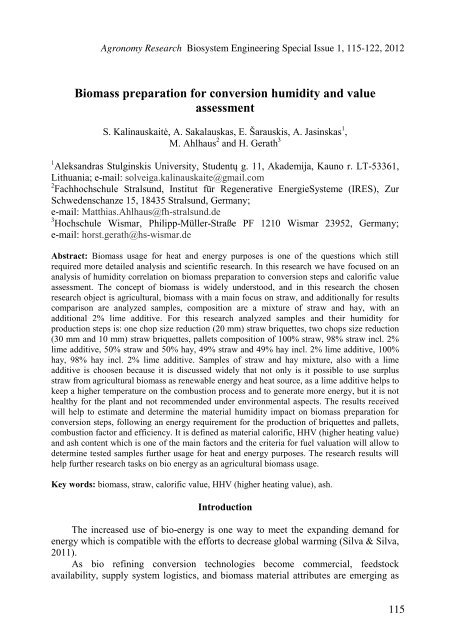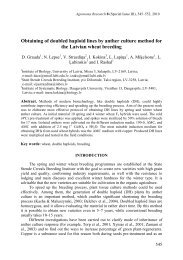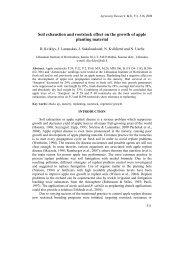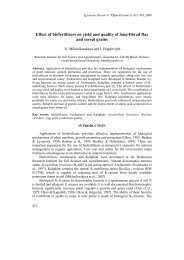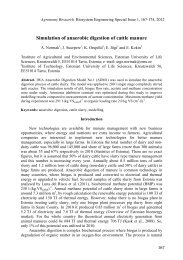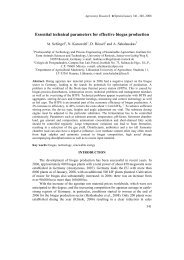Full text PDF (299 K) - Agronomy Research
Full text PDF (299 K) - Agronomy Research
Full text PDF (299 K) - Agronomy Research
You also want an ePaper? Increase the reach of your titles
YUMPU automatically turns print PDFs into web optimized ePapers that Google loves.
<strong>Agronomy</strong> <strong>Research</strong> Biosystem Engineering Special Issue 1, 115-122, 2012<br />
Biomass preparation for conversion humidity and value<br />
assessment<br />
S. Kalinauskaitė, A. Sakalauskas, E. Šarauskis, A. Jasinskas 1 ,<br />
M. Ahlhaus 2 and H. Gerath 3<br />
1<br />
Aleksandras Stulginskis University, Studentų g. 11, Akademija, Kauno r. LT-53361,<br />
Lithuania; e-mail: solveiga.kalinauskaite@gmail.com<br />
2<br />
Fachhochschule Stralsund, Institut für Regenerative EnergieSysteme (IRES), Zur<br />
Schwedenschanze 15, 18435 Stralsund, Germany;<br />
e-mail: Matthias.Ahlhaus@fh-stralsund.de<br />
3<br />
Hochschule Wismar, Philipp-Müller-Straße PF 1210 Wismar 23952, Germany;<br />
e-mail: horst.gerath@hs-wismar.de<br />
Abstract: Biomass usage for heat and energy purposes is one of the questions which still<br />
required more detailed analysis and scientific research. In this research we have focused on an<br />
analysis of humidity correlation on biomass preparation to conversion steps and calorific value<br />
assessment. The concept of biomass is widely understood, and in this research the chosen<br />
research object is agricultural, biomass with a main focus on straw, and additionally for results<br />
comparison are analyzed samples, composition are a mixture of straw and hay, with an<br />
additional 2% lime additive. For this research analyzed samples and their humidity for<br />
production steps is: one chop size reduction (20 mm) straw briquettes, two chops size reduction<br />
(30 mm and 10 mm) straw briquettes, pallets composition of 100% straw, 98% straw incl. 2%<br />
lime additive, 50% straw and 50% hay, 49% straw and 49% hay incl. 2% lime additive, 100%<br />
hay, 98% hay incl. 2% lime additive. Samples of straw and hay mixture, also with a lime<br />
additive is choosen because it is discussed widely that not only is it possible to use surplus<br />
straw from agricultural biomass as renewable energy and heat source, as a lime additive helps to<br />
keep a higher temperature on the combustion process and to generate more energy, but it is not<br />
healthy for the plant and not recommended under environmental aspects. The results received<br />
will help to estimate and determine the material humidity impact on biomass preparation for<br />
conversion steps, following an energy requirement for the production of briquettes and pallets,<br />
combustion factor and efficiency. It is defined as material calorific, HHV (higher heating value)<br />
and ash content which is one of the main factors and the criteria for fuel valuation will allow to<br />
determine tested samples further usage for heat and energy purposes. The research results will<br />
help further research tasks on bio energy as an agricultural biomass usage.<br />
Key words: biomass, straw, calorific value, HHV (higher heating value), ash.<br />
Introduction<br />
The increased use of bio-energy is one way to meet the expanding demand for<br />
energy which is compatible with the efforts to decrease global warming (Silva & Silva,<br />
2011).<br />
As bio refining conversion technologies become commercial, feedstock<br />
availability, supply system logistics, and biomass material attributes are emerging as<br />
115
major barriers to the availability of corn stover for biorefining. The material<br />
characteristics of corn stover creates barriers with any supply systems design in terms<br />
of equipment capacity/ efficiency, dry matter loss and capital use efficiency (Hess J.R<br />
et al., 2009).<br />
Biomass can be converted into energy (heat or electricity) or energy carriers<br />
(charcoal, oil or gas) using both thermochemical and biochemical conversion<br />
technologies. Combustion is the most developed and most frequently applied process<br />
used for solid biomass fuels because of its low costs and high durability. During the<br />
combustion process, the biomass first loses its moisture at temperatures of up to 100°C,<br />
using heat from other particles that realise their heat value. As the dried particles heat<br />
up, volatile gases containing hydrocarbons, CO, CH4 and other gaseous components<br />
are realised. In a combustion process, these gases contribute about 70% of the heating<br />
value of the biomass (Gravalos et al., 2010).<br />
The use of biomass feedstock from agricultural sources for the bio energy<br />
production might play a key role, since it would allow to pursue the following three<br />
objectives: 1) reducing emissions of the greenhouse gases, 2) diversifying energy<br />
sources to reduce dependence on oil and gas, 3) indentifying productive alternatives<br />
and new sources of income to farmers especially in areas affected by the process of<br />
agro-industrial conversion (Librenti et al., 2010).<br />
Biomass moisture significantly influenced comminution energy consumption<br />
(Miao Z. et al., 2011).<br />
Compared to the incineration of fossil fuels the overall CO2 balance is<br />
considerably less affected by the usage of biomass. An important property of fuel is its<br />
heating value. The so called ‘higher heating value’ (HHV) is the enthalpy of the<br />
complete combustion of a fuel with all carbon converted to CO2, and all hydrogen<br />
converted to H2O. The higher heating value is given for standard conditions (101 kPa,<br />
25°C) of all the products and includes the condensation enthalpy of water Varmuza et<br />
al., 2007).<br />
The ashes are the inorganic material that remains after biomass burning. They<br />
contain mainly calcium, magnesium and phosphorus, elements that effect the ash<br />
fusion. The ash fusibility is a key parameter for evaluating the biomass performance in<br />
plants. (Librenti et al., 2010).<br />
The field of thermo chemistry is one of the foundation stones of a modern energy<br />
society. The proximate and ultimate analysis of biomass and coal are necessary for<br />
their efficient and clean utilization while the HHV of these materials determine the<br />
quantitative energy content of these fuels (Parikh et al., 2005).<br />
116<br />
Materials and methods<br />
<strong>Research</strong> was performed at Fachhochschule Stralsund laboratory. For the research<br />
two different particle size briquettes were chosen. Examples produced by one chop (20<br />
mm) and two chop (30 mm and 10 mm) fractions together with six examples of pallets<br />
which composition is of 100% straw, 100% straw pallets, 98% straw incl. 2% lime<br />
additive, 50% straw and 50% hay, 49% straw and 49% hay incl. 2% lime additive,<br />
100% hay, 98% hay incl. 2% lime additive.<br />
Samples humidity and its correlation was determinated on different material<br />
preparation to conversion phases. Tested examples succession are:
- samples preparation to conversion stages (briquettes): material from bale,<br />
material after one chop size reduction, material after two chop size<br />
reduction, final product- straw briquettes;<br />
- samples preparation to conversion stages (pellets): material from bale,<br />
material after crusher, material before press, final product- pellets.<br />
All samples taken for research were hermetically closed to keep the present<br />
humidity and to avoid any parameters changes. Humidity was determinated in the<br />
laboratory, examples were dryed in the oven (WS 51) at a constant 100°C temperature,<br />
and additional measurements were taken in periods after 3 h plus 1 h. Samples taken<br />
from the oven were held for 1 h in a dish to equalize temperature and to absorb the<br />
remaining humidity. To receive objective results and accuracy it each material sample<br />
was measured three times.<br />
Samples calorimetre value were determined with IKA Calorimeter C 4000<br />
adiabatic, which follows DIN 51900, ASTM 240 D, ISO 1928 standards. Samples<br />
material has been milled with el. mill Fritsch (max power 1800 W), used sieve with<br />
holes 0.5 mm in diameter, received milled material in 0.25–0.5 mm particles fraction.<br />
Further steps were to measure quartz crucible first empty and then with samples<br />
in 0.1 g accuracy, 0.7 g of each test samples have been measured. The inhibit wire and<br />
the tied up cotton thread has been fastened. Bomb was filled in with 5–10 ml distilated<br />
water. Prepared subtance were put inside of the bomb, and bomb cover has been<br />
bolted. Bomb was filled with 30 bar oxygen. Installed bomb was added into IKA<br />
Calorimeter C 4000 adiabatic. Determinated begining ( t E ) and end ( t A ) temperature.<br />
After the process in calorimeter was over, bomb was taken out, cover is opened, inside<br />
of bomb liquid was filled 0.1% Phenolphtalin was used to indentify the acidity and<br />
titration to know 0.1 N NaOH-solution amount in ml. This parameter is used to<br />
calculate heat amount by measuring acid processing.<br />
Fig. 1. Calorimeter bomb.<br />
Fig. 2. IKA Calorimeter C 4000 adiabatic.<br />
According to the received results it was calculated HHV (higher heating value),<br />
which assumes that all of the water in a combustion process is in a liquid state after a<br />
combustion process. In accordance with DIN 51900 by the term „heat value” only<br />
lower heat value is understood, while a higher heating value is called calorific value,<br />
which is calculated by formula (1):<br />
117
C – Thermal capacity of calorimeter system, koeficientas 8410.31, J K -1<br />
C � �t<br />
� QF<br />
H o,<br />
f �<br />
mP,<br />
f<br />
� t – difference of the temperature, K;<br />
Q – sum of amount of heat, J;<br />
F<br />
m p,<br />
f – mass (of moist sample), g; (DIN 51900T1); (DIN 51900T2); (DIN 51900T3);<br />
(Warn J. R. W & Peters A.P.H, 1996).<br />
118<br />
Results and discussion<br />
The humidity variation of material in preparation to conversion steps was<br />
determined starting from material in bale till the endproduct – briquettes and pellets.<br />
To testing briqutte‘s production phases and preparation to conversion steps, material<br />
was taken from bale, after one chop size reduction, after two chop size reduction, and<br />
final product- straw briquettes.<br />
The regression equation and correlation coefficient of humidity in production<br />
steps of straw briquette samples of one chop fraction (20 mm) and two chop fractions<br />
(30 mm and 10 mm) are represented in (Fig. 1) and (Fig. 2). Results show that one<br />
chop fraction briquette humidity and its production strongly depend on the humidity of<br />
2<br />
start up material, correlation coeficient R = 0.6904. But in the case of two chop<br />
fraction briquette, results showed that humidity starting from primary material in the<br />
bale and on the other stages do not have influence on final product product, correlation<br />
2<br />
coefficient R = 0.1241.<br />
Fig. 1. The influence of humidity on<br />
preparation steps to conversion<br />
(100% straw briquette, one chop).<br />
(1)<br />
Fig. 2. The influence of humidity on<br />
preparation steps to conversion<br />
(100% straw briquette, two chop).<br />
In order to test pallets production and preparation to conversion stages, material<br />
from bale after crusher, before press, and final product- pallets are taken.
Analysed 100% straw pallets (Fig. 3) and pallets produced on composition 98%<br />
straw incl. 2% lime (Fig. 4) and the received results of humidity influence on<br />
production steps has showed that there is a strong correlation in both cases.<br />
Fig. 3. The influence of humidity on<br />
preparation steps to conversion<br />
(100% straw pellets).<br />
Fig. 4. The influence of humidity on<br />
preparation steps to conversion (98%<br />
straw pellets incl. 2% lime).<br />
<strong>Research</strong>ed pallets composition of 50% straw and 50% hay (Fig 5) and 50%<br />
straw and 50% hay incl. 2% lime (Fig. 6) showed there is a strong humidity correlation<br />
coefficient in all preparation steps. Attention should be noted that pallets with a 2%<br />
lime additive has a stonger correlation on the humidity impact during production steps.<br />
Fig. 5. The influence of humidity on<br />
preparation steps to conversion (50%<br />
straw and 50% hay pellets).<br />
Fig. 6. The influence of humidity on<br />
preparation steps to conversion (49%<br />
straw and 49% hay pellets incl. 2%<br />
lime).<br />
Evaluating pellets composition of 100% hay (Fig. 7) and 98% hay incl. 2% lime<br />
additive (Fig. 8) humidity dependence on the earlier mentioned production stages and<br />
2<br />
humidity measuring phases for 100% hay pallets R =0.4866, for pallets of 98% hay<br />
incl. 2% lime additive,<br />
2<br />
R = 0.5566. Lime additive has influenced the pallets<br />
production process and humidity factor.<br />
119
120<br />
Fig. 7. The influence of humidity on<br />
preparation steps to conversion<br />
(100% hay pellets).<br />
Fig. 8. The influence of humidity on<br />
preparation steps to conversion (98%<br />
hay pellets incl. 2% lime).<br />
HHV (higher heating value) was calculated under results received on the<br />
laboratoty test of calorimetry. Additional criteria for analysis was taken and evaluated<br />
for non treatment straw samples from bale. Each test results incl. three repetition is<br />
showed (Fig. 9). The lowest HHV value were determined on non treatment straw taken<br />
directly from the bale and in pallets which composition is 50% straw and 50% hay<br />
samples. Higher figures were achieved in all analysed samples with 2% lime additives.<br />
Analyzing seperately 100% straw briquette and 100% straw pallets HHV results, a<br />
higher amount was determined on 100% straw briquette samples.<br />
Fig. 9. HHV (higher heating value) of tested material.<br />
Determined ash content % (of solid mass) at tested samples and their values are<br />
represented in the diagram (Fig. 10). It is noteworthy that the lowest amount of ash has<br />
been defined as the straw briquette sample, the highest amount – at pellets composition<br />
of 50% straw and 50% hay. The ash content in non treatment straw from the bale is<br />
higher than in 100% straw briquettes samples. Ash quantity at 100% straw pellets is
one of the higher values. In the samples which includes a 2% lime additive, the<br />
determined ash quantity is lower then at adequate examples.<br />
Fig. 10. Ash content, % of tested material.<br />
Conclusions<br />
The represented research is focused on the analysis of humidity correlation<br />
through biomass preparation to conversion steps and energy value assessment. Defined<br />
material calorific, HHV (higher heating value) and ash content value, which is one of<br />
the main factors and criteria for fuel valuation, and it was determined that:<br />
- One chop fraction briquette humidity and its production strongly belong on<br />
start up material humidity;<br />
- Material preparation to conversion steps for pellets has a stonger correlation<br />
on humidity impact then for briquettes;<br />
- Samples preparation to conversion steps of pellets with 2% lime additive has<br />
a stonger correlation on the humidity impact then the remaining tested<br />
pallets samples;<br />
- The lowest HHV value were determined on samples which consist of non<br />
treatment straw taken directly from the bale and in pellets which<br />
composition is 50% straw and 50% hay, accordingly values average 15,695<br />
(J g -1 ) and 15,663 (J g -1 ). Higher figures were achieved in all samples with<br />
2% lime additives;<br />
- Higher heating value was determined on 100% straw briquette samples then<br />
on 100% straw pellets;<br />
- Lowest amount of ash has been defined as the straw briquette sample, value<br />
3,03%, the highest amount – at pellets which composition is 50% straw and<br />
50% hay, value 8,5%.<br />
121
122<br />
References<br />
DIN 51900T1 ‘Determination of the calorific value with bomb Calometer and computation of<br />
the heat value, general Anga ben basic equipments basics procedures’ Expenditure August<br />
1997.<br />
DIN 51900T2 ‘Determination of the calorific value with bomb Calometer and computation of<br />
the heat value, procedure also isotherms coat’ Expenditure August 1977.<br />
DIN 51900T3 ‘Determination of the calorific value with bomb Calometer and computation of<br />
the heat value, procedure also adiabatic coat’ Expenditure August 1977.<br />
Gravalos I., Kateris D., Xyradakis P., Gialamas T., Loutridis S., Augousti A., Georgiades A. &<br />
Tsiropoulos Z. 2010. A study on calorific values of biomass residue pallets for heating<br />
purpose. FORMEC 2010. Forest Engineering: Meeting the needs of the Society and the<br />
Environment July 11–14, 2010. Padova – Italy.<br />
Hess R.J., Kenney K.L., Wright C.T., Perlack R. & Turhollow A. 2009. Corn stover availability<br />
for biomass conversion: situation analysis. Cellulose. 16, 599–619.<br />
Librenti L., Ceotto E. & Di Candilo M. 2010. Biomass characteristics and energy contents of<br />
dedicated lignocellulosic crops. Third International Symposium of Energy from Biomass<br />
and Waste.<br />
Miao Z, Grift T.E, Hansen A.C. & Ting K.C. 2011. Energy requirement for comminution of<br />
biomass in relation to paticle physical properties. Industrial crops and products. 33, 504–<br />
513.<br />
Parikh J., Chaniwalla S.A. & Ghosal G.K. 2005. A correlation for calculating HHV from<br />
proximate of solid fules. Fuel, 84, 487–494.<br />
Silva R.M & Silva A.J. 2011. The potential benefits and risks to the environment in using bioenergy.<br />
Syst Pract Res, 24, 545–554.<br />
Varmuza K., Liebmann B. & Friedl A. 2007. Evaluation of the heating value of biomass fuel<br />
from elemental composition and infrared data. Chemistry. Scientific papers 35 (5), 5–10.<br />
Warn J. R. W & Peters A.P.H, 1996. Concise Chemical Thermodynamics. Taylor & Francis elibrary,<br />
2005. 204 pp.


